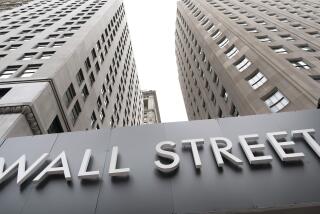U.S. stocks slammed by global fears
- Share via
First it was fresh concerns about the fragile Eurozone recovery. Then there was the sudden steep fall in oil prices. Now investors are worrying whether the American economy can pull up a slumping global economy.
And overlaying all these — fears about the spread of the deadly Ebola virus.
A weak monthly U.S. retail sales report magnified the angst Wednesday in European financial markets, setting off wild swings on Wall Street and fueling speculation that the Federal Reserve could delay its first interest rate hike or even reverse plans to end its bond-buying stimulus program this month.
After plunging more than 450 points in midday trading, the Dow Jones industrial average ended down 173.45, or nearly 1.1%, at 16,141.74.
It was the Dow’s fifth straight day of losses as investors dumped stocks and raced toward the safety of government bonds. The broader Standard & Poor’s 500 stock index fell 0.8%. The blue-chip index has fallen in 10 of the last 12 days, wiping out its gains year to date.
“When people buy, they buy hesitantly, versus when people sell…. They sell with abandon,” said Carter Braxton Worth, chief market analyst at brokerage Sterne Agee in New York, describing the mood on his company’s trading floor as “charged.”
Most analysts, however, aren’t worried — not yet. The Dow is still up more than 6% from a year ago and the S&P even more. Stocks appeared to be overdue for a correction — a 10% drop — especially after months of increases amid unusually calm waters.
Meanwhile, analysts noted, the outlook for the U.S., European and global economies has changed little in recent weeks. The Eurozone’s stagnant economy looks a bit worse off than before, with Germany’s engines weaker than expected, but no one was counting on a rapid recovery in the 18-nation single-currency market.
Crude oil prices have tumbled, but there are upsides to that for some nations and businesses, as well as for consumers who are seeing prices at the gasoline pumps fall.
As for the U.S. economy, the 0.3% drop in retail sales in September from the previous month, while disappointing, came on the heels of very strong auto sales over the summer.
What’s more, with job gains running faster this year, most forecasts see the American economy growing at a healthy pace of about 3% in the second half of this year and through next year.
“It’s a temporary phenomenon,” Sara Johnson, senior research director of global economics at consulting firm IHS Inc., said of the turmoil in financial markets. “Certainly the outlook for business profitability would not warrant a sharp pullback as we’ve seen in the past few weeks.”
Diane Swonk, chief economist at Mesirow Financial in Chicago, thinks stock prices got ahead of fundamentals earlier and now they’re overshooting on the downside.
“The reality is that markets are overreacting right now,” she said, noting that Wednesday’s sell-off in Europe, where all the major indexes except the London FTSE 100 fell 2% to 3.6%, was magnified by unsupported headlines that the U.S. retail sales report was signaling a sudden retreat by American consumers.
If the stock market swoon persists in the days ahead, Swonk and other economists worry that it could undermine confidence and hurt spending and investment. It doesn’t help that there are increasing concerns about Ebola and the ability of health authorities to halt the spread of the virus in the U.S.
Geopolitical tensions in Ukraine and the battle against Islamic militants have added to anxieties. “It’s an environment that’s just paralyzing the bulls,” said John Lonski, chief capital markets economist for Moody’s Analytics.
In addition, October historically has been very tough for stock markets.
“It’s Halloween in the United States and we all get scared,” Swonk said, only half jokingly. She pointed out that the 85th anniversary of the 1929 crash will come Oct. 29.
That also happens to be the day when the Fed will hold its next policy meeting. Further volatility in capital markets — stocks, oil prices and bond yields — could present a major challenge as financial stability is a key goal of the central bank.
Fed policymakers have relied on two extraordinary measures — monthly bond purchases and low benchmark Fed rates — to spur the economic recovery from the Great Recession.
They previously indicated that they would end their bond-buying program this month, but some market players suspect that could now be put off, or even that a new round of bond purchases could be launched. And the markets have revised their bets that the first interest rate hike will come next June to December next year.
“It does put the Fed in a sticky situation because financial stability is the third pillar that they have to deal with,” Swonk said of the Fed’s primary objectives, which also include maximizing employment and controlling inflation.
For now, Swonk and most other analysts expect the Fed to end the bond purchases this month.
Moreover, unless the picture of U.S. growth deteriorates noticeably, “there is a strong likelihood that these latest market moves will be reversed sooner rather than later,” said Paul Ashworth of Capital Economics, “and that the Fed will still begin to hike rates sometime in the first half of next year.”
The prospect of a rate increase has added to jitters about a global economy that has few bright spots outside of the U.S.
Besides the Eurozone, China’s economic growth as well as that of emerging economies in general is slowing. That explains part of the recent plunge in oil and some other commodity prices, which in turn has added to concerns about the possibility of falling prices, or deflation, in the Eurozone.
Analysts said the outlook in Europe could improve if Germany, the continent’s largest economy, were to increase domestic investment and spending, as it is under growing pressure to do.
Mark Zandi, chief economist at Moody’s Analytics, hasn’t changed his outlook but has raised his calculation of risks for the economy.
What struck him about the latest turmoil in markets wasn’t the fall in stocks and oil prices, but bond rates. On Wednesday, the yield on the 10-year Treasury, a benchmark for mortgage rates, fell momentarily to less than 2%. It closed at 2.14%, down 0.056 point, the lowest in more than a year.
“Two percent is really shocking for an economy growing at 3% experiencing robust job growth,” Zandi said.
The drop, from 2.62% less than a month ago, already has triggered a bump in mortgage refinancings. But although that may be good for now, the fact that the yield has fallen that low could be a harbinger of trouble if it stays there for more than a month or so.
“It’s a barometer of fear,” he said, noting that if it were to last, the jolt to confidence could affect consumer spending and hiring by businesses. “And that’s a whole different ballgame.”
More to Read
Inside the business of entertainment
The Wide Shot brings you news, analysis and insights on everything from streaming wars to production — and what it all means for the future.
You may occasionally receive promotional content from the Los Angeles Times.











